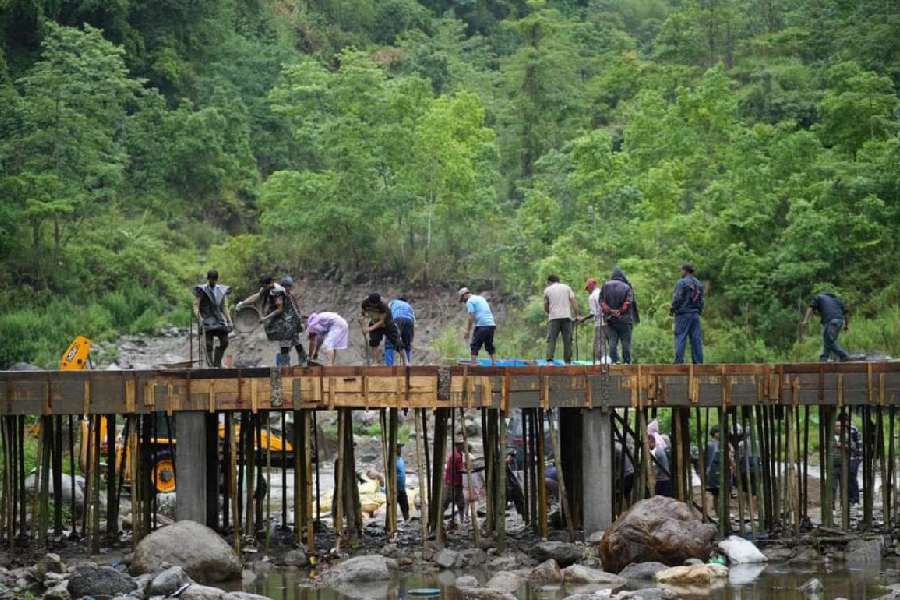Villagers are constructing a 130-foot-long concrete motorable bridge in Darjeeling, a lifeline that governments have failed to build in decades.
In the thick of things is Ajoy Edwards, a relatively new politician in the hills with his Hamro Party, but he has stressed that this is an “apolitical initiative” with villagers irrespective of their political affiliations.
The bridge is being built over Chota Rangit river connecting Singtom tea garden with Pulbazar-Bijanbari area.

Ajoy Edwards chips in with villagers to build the bridge. The Telegraph
During the British era, a suspension bridge was built for people and horses to cross the river. This was the most used road during earlier times with strong business ties between Darjeeling and Pulbazar-Bijanbari area.
At the moment there are two circuitous routes to reach Bijanbari from Darjeeling — one through Ghoom-Jorebunglow and the other through Jamuni. “While the two routes need anything between one-and-half to two hours to cover the distance, this bridge would ensure that the distance will be covered in half an hour,” said Edwards.
There has always been a demand to build a motorable bridge through the old route. “It seems this has been a poll issue of the area for decades,” said Edwards.
Edwards’s involvement with the plan started when he started distributing relief during Covid-19 in 2000.
"While visiting the area during Covid days I had told the villagers that I would be a part of this bridge initiative if the villagers joined hands,” said Edwards.
Nothing moved for around four years.
Early this year villagers of more than 20 villages decided to build the bridge on their own.
Edwards decided to contribute raw materials and the daily wages of seven to eight masons. The villagers decided to contribute free labour, including procuring raw materials like sand and break stones from the river.
For the past three months, villagers have been working long days to build the bridge.
Edwards has spent around Rs 20 lakhs on the project so far. “But the contribution of the villagers is much more," he said. "Last Sunday, when we had to cast the slab of the bridge, over 350 people turned up to volunteer.”
The story of the bridge is intertwined with the politics of Darjeeling.
The Singtom-Pulbazar Bijanbari area was predominantly CPM when the Subash Ghisingh-led Gorkha National Liberation Front (GNLF) led the Gorkhaland agitation.
Clashes between the CPM and the GNLF were frequent.
When the Darjeeling Gorkha Hill Council (DGHC) elections were held in 1988, the GNLF swept the hills but the Chungthung-Marybong and Pulbzar-Bijanbari seats still went to the CPM.
"In 1992, the (CPM-led) state government wanted to construct a bridge over the river at an approximate cost of Rs 2 crore but despite laying the foundation stone the project could not start as the DGHC did not provide the no-objection certificate,” said Saran Gurung, a resident of the area, who added that he joined the initiative because Edwards has termed the initiative “apolitical.”
Again in the late 1990s, CPM MP S.P. Lepcha, also a resident of Singtom, sanctioned an amount to build the bridge.
"The government erected three pillars but that was it. There was no further progress,” said Gurung.
Even Gurung, a contractor by profession, has pooled around Rs 2 lakhs for the project. “My people from outside that region have also contributed by paying for cement and other costs,” said Edwards.
More than 75 per cent of the bridge is complete. “We are confident of completing the bridge in the next 15 days before monsoon sets in,” said Edwards.











